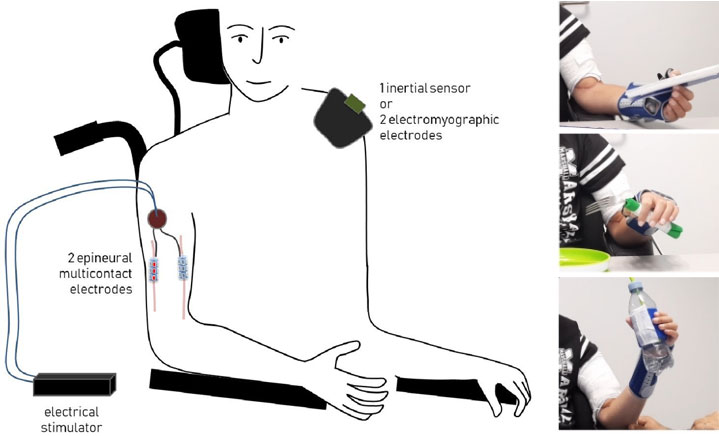by Christine Azevedo Coste (Inria), David Guiraud (NEURINNOV) and Charles Fattal (Centre Bouffard-Vercelli, USSAP)
The objective of our research is to provide different hand movements using only two epineural electrodes implanted above the elbow in individuals with hand paralysis. Each multi-contact cuff electrode can be configured to electrically stimulate different fascicles of the nerve, eliciting the contraction of different muscles. The user controls the neuroprosthesis by executing stereotyped movements or activating muscle contractions that are interpreted by the piloting interface as orders to trigger the stimulation. Two participants with complete tetraplegia were implanted with two electrodes for 28 days and were able to grasp different types of objects for the first time since their spinal cord injury.
People with complete tetraplegia are dependent on caregivers for activities of daily living (bathing, dressing, eating, self-care, etc.). In some situations, functional surgery can partially restore hand and wrist movements to produce useful but limited functions. Functional Electrical Stimulation (FES) can activate muscles with intact motor neurons located below the spinal cord injury by applying electrical pulses of current to excitable tissue. FES can be applied using surface, percutaneous or implanted electrodes. As the forearm muscles are small and sometimes deep, implanted stimulation was considered relevant to restore hand function. To date, the proposed solutions require the insertion of an electrode in each muscle involved in the movement to be restored. A commercial device was available decades ago: the Freehand system (Neurocontrol). It has been implanted in more than 250 people (Keith et al, 1989). Up to 12 intramuscular electrodes were inserted in the arm muscles and various movements could be induced. Despite the benefits reported by users, marketing was stopped in 2001 for mainly economic reasons. One of the disadvantages of the device was the high number of electrodes and cables implanted in the body as well as a surgical procedure lasting about six hours.

Figure 1: Left: AGILIS solution: two multi-contact neural stimulation electrodes are wrapped around medial and radial nerves. The user mobilises his/her sus-lesional muscles to send orders to the controller of the electrical stimulator to activate the corresponding electrode configuration and induce the intended hand action. Right: Examples of object grasping.
In a previous study, we investigated the possibility of activating different muscle groups innervated by the same nerve using a multi-contact cuff electrode wrapped around the median or radial nerves (Tigra et al., 2020). We designed mathematical models of the nerve–electrode interface and extracted from simulation results the most selective electrode configurations. We developed an electrical stimulator capable of controlling multichannel electrodes. After acceptance of the protocol by the ethics committee and the national competent authority, 10 participants with complete tetraplegia accepted our intervention during a scheduled functional musculotendinous surgery. During surgery, under anaesthesia, the median nerve (flexion movements) or the radial nerve (extension movements) was exposed and an electrode positioned. We systematically scanned different pre-programmed electrode configurations (contact arrangement and electrical stimuli parameters) and observed the induced movements. The electrode was then removed, and the surgical procedure continued. The analysis of the movements induced by the different configurations confirmed the possibility of activating different muscles with a single electrode. Based on these results, we launched a new project: AGILIS [L1]. AGILIS proposes to use only two neural electrodes to drive the extension and flexion movements of the hand: multi-contact electrodes placed around the median and radial nerves to activate different muscles depending on the contact configuration and the stimulation parameters. These neural electrodes were implanted for 28 days in two volunteers with tetraplegia. During this period, the configuration of the electrodes could be individually optimised and the progression of performance evaluated longitudinally. An intuitive interface was designed to allow the user to control the assistive device and to increase the embodiment of the technology.
The electrodes were placed during a first surgical procedure and explantation performed 28 days later during a second surgical procedure. The complete device consisted of two multi-contact electrodes (CorTec GmbH Freiburg Germany) with their individual percutaneous cable and extracorporeal connector, two extracorporeal cables, and one multi-source external stimulator (STIMEP, Inria, Montpellier) connected to a computer. Wireless sensors (Delsys, Natick, MA) were placed on the skin to measure voluntary muscle signals (electromyography (EMG)) and voluntary movements (inertial measurement units (IMU)). These signals were processed to detect the user's steering commands. Users could autonomously trigger stimulation using their contralateral limb: stereotyped shoulder movements or muscle contractions of muscles above the spinal cord lesion. A finite state machine (FSM) was defined to associate user commands (detection of muscle activation thresholds or recognition of a predefined movement) with actions.
It was possible to generate various functional movements in the two participants, allowing them to grasp various objects of everyday life [3]. Our study suggests that multi-contact cuff electrodes combined with multi-source electrical stimulation offers the possibility of selectively activating nerve fascicles in a reproducible manner. Multipolar neural electrical stimulation of the median nerve and radial nerve allowed for useful grasp and release in both participants. Future studies will consolidate this proof of concept by expanding the number of participants.
Link:
[L1] https://www.eithealth.eu/agilis
References:
[1] M.W. Keith, et al.: “Implantable functional neuromuscular stimulation in the tetraplegic hand”, J Hand Surg Am 14, 524–530, 1989
[2] W. Tigra, et al.: “Selective neural electrical stimulation restores hand and forearm movements in individuals with complete tetraplegia”, J Neuroeng Rehabil 17, 66, 2020.
[3] C. Fattal et al.: “Restoring Hand Functions in People with Tetraplegia through Multi-Contact, Fascicular, and Auto-Pilot Stimulation: A Proof-of-Concept Demonstration”, Journal of Neurotrauma, 2022
Please contact:
Christine Azevedo Coste, Inria France











